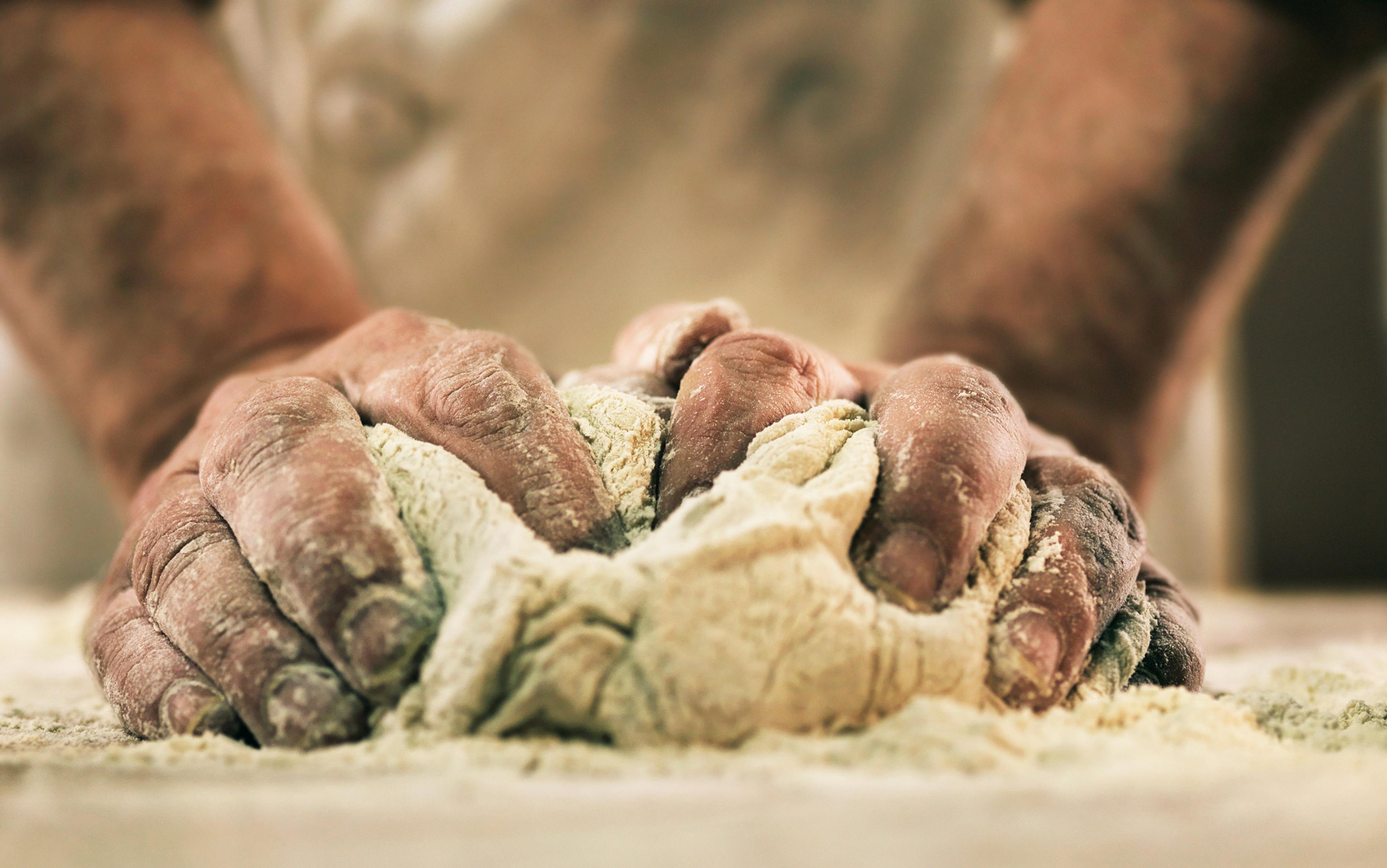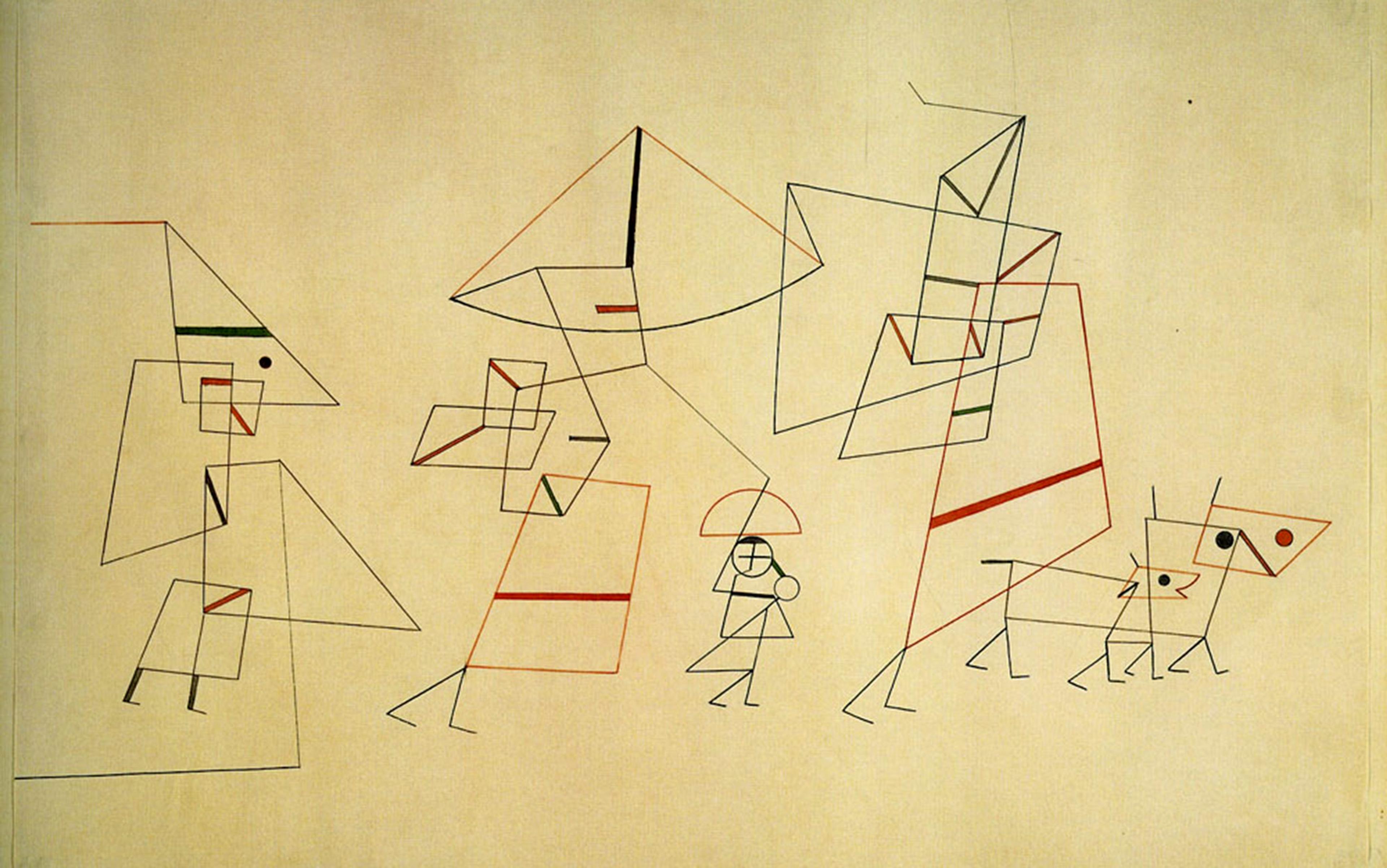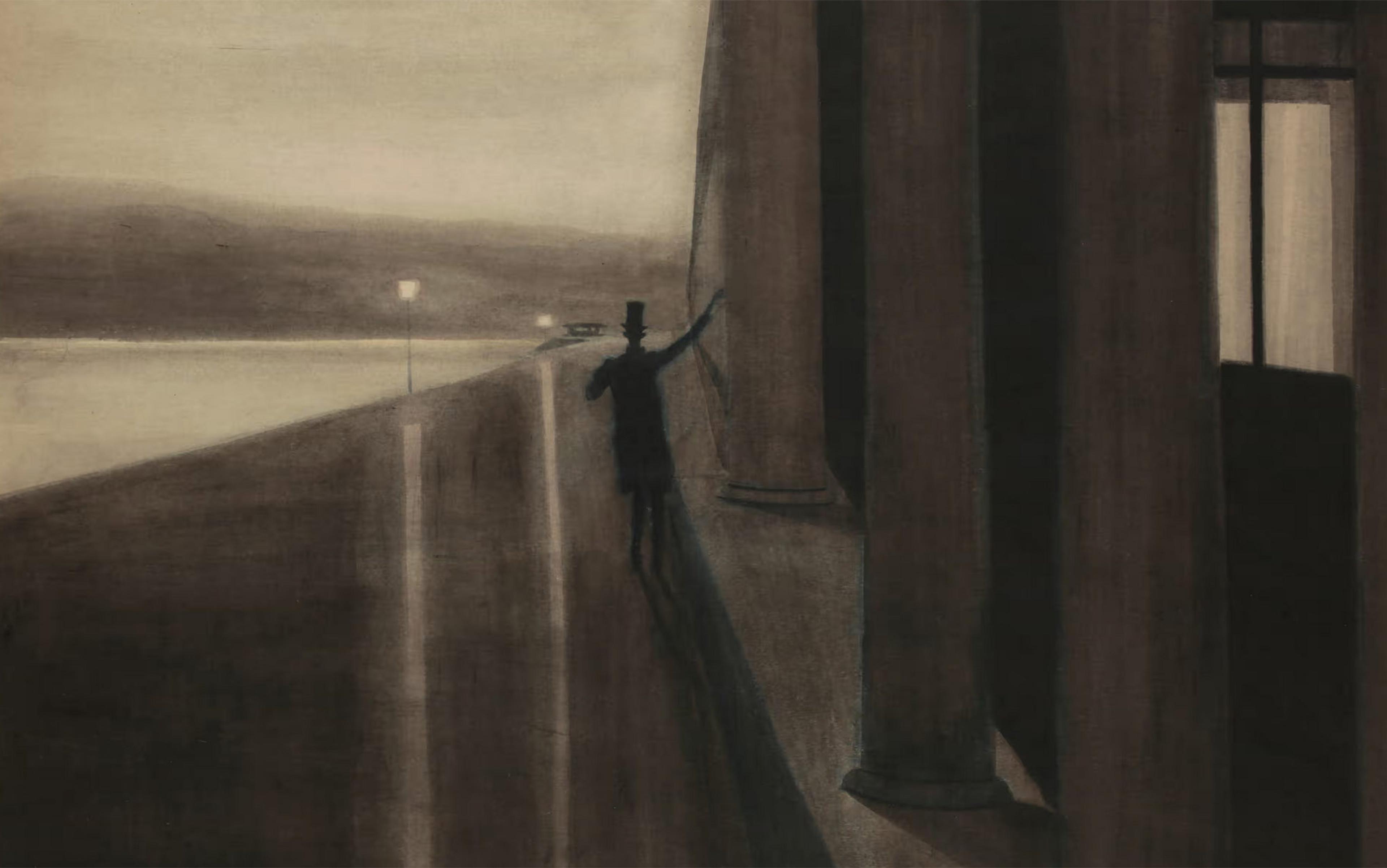The sort of bread I really like to make is the sort of bread that takes time. You have to start early in the morning, set your alarm even. Though if the thought is in your head you might find you wake naturally with the sunlight, feeling refreshed, squatting on time’s hoard. Just before seven, you pad down in your dressing gown and crack the lid on the big Tupperware pot of leaven.
Treat yourself. Put your nose in and smell the sour, yeasty draught. Inspect the slow bubbles with approval. Then, positioning the big antique mixing bowl — pale blue inside, cream on the outside — on the electronic scales, ladle a great draught of leaven into it. It’s the consistency of thick batter, this leaven. Flour, salt, water will follow. With one hand, you start to mix — palm passing through the cool flour, fingertips deep in sticky leaven, which squidges back through the gaps between your fingers as you close your hand around it.
Soon a wet glob of dough adheres to your hand. With your clean hand you smear a dollop of sunflower oil on the kitchen surface and, deftly as you can, you knead the dough on this, keeping it moving so it doesn’t stick. Somehow, you bring it to a rough ball — scraping it off your hands as you go – then you oil the mixing bowl, place the dough there and cover it with clingfilm.
‘Empty carbs,’ says my wife (when she’s not scoffing it). ‘Staff of life,’ say I
Then you make a cup of tea. In 10 minutes you’ll knead it, reshape it and return it to the bowl. Then another 10 minutes. Then another 10 minutes. Then half an hour. Then an hour, and so on through the day. It needs regular intermittent attention, like a young baby. By around teatime, the magic will have happened. It will be elastic, risen, alive, with a gentle sheen on the surface and maybe a big bubble just visible. When you knock it back, it will pop and squeak slightly. After its final rise, you’ll shape it and put it into a well-floured, linen-lined banneton to prove.
Finally, if you haven’t screwed up — if it doesn’t stick to the linen, tear, deflate and break your heart — you’ll turn it out onto a peel or paddle dusted with semolina, slash a swift cut or two on the top, spritz it with a fine mist of water and whack it into a very hot oven. If you’re like me, you’ll then watch it through the oven window — anxious, like the parent of that young baby watching, through glass, as it undergoes an operation. Oven-spring is what you’re looking for: the yeast doing its thing, lifting and slightly scalloping the edges of the loaf at the bottom, puffing the top, easing open that slash you made — the yeast offering up a last great burst of energy in the rising warmth, never more alive than just before the heat kills it.
No other form of cookery, to me, is as profoundly satisfying as the baking of sourdough bread. I know that I’m not alone. There are a lot of bread-heads about, and disproportionately, these bread-heads seem to be men. It’s men who get really excited about bread, its nuts and bolts, its existential appeal. We are going through an era of bread obsession fuelled by celebrity bakers: Paul Hollywood, Dan Lepard, Richard Bertinet, Andrew Whitley, the Fabulous Baker Brothers, the Hairy Bikers.
On Twitter, the hashtags #breadporn and #realbread tell their own story: one of mouthwatering Instagrammed crusts, close-ups of crumb-structure, and intricate golden landscapes where the slashed tops of loaves have heaved open and caramelised in the oven’s heat. Those are mostly boys, too. It’s a corner of the culinary life that (other than showing off for dinner parties and with barbecues) really gets the boys going. So what’s the appeal?
It’s not greed. Okay, that’s not true. It is greed. In my case, as in many others, a prime attraction is that I really, really like to eat bread. As a last meal, I would probably be happy with bread and butter — assuming the bread was an absolutely shit-hot sourdough, just sliced; or something beery and malted and tangy with rye, slathered with proper French butter with salt crystals in it (unsalted butter is an ingredient for cooking, not a foodstuff for eating). Lots of women — thanks to the body-fascism of the ambient patriarchal discourse, obviously — regard bread with suspicion. ‘Empty carbs,’ says my wife (when she’s not scoffing it). ‘Staff of life,’ say I.
But there’s more to it than greed. It goes deeper. I love to cook all sorts of things, and it’s not as if I’m indifferent to the pleasures of eating those things either. Twenty-four-hour cooked shoulder of pork? Poached eggs with asparagus? Orecchiette pasta with sausage, chilli, garlic, cream, Parmesan and tenderstem broccoli? Sign me up to that shizzle. But bread? Bread’s different. There’s something atavistic about it.
There’s the simplicity, to start with. Bread contains flour, water, yeast and salt. That’s it. Even yeast and salt are, you could argue, optional extras. Putting a loaf on the table in front of your family — this beautiful, aromatic, crusty, porous, individual-as-a-snowflake hunk of sustenance — is Neolithic stuff. Our hunting fathers weren’t faffing about with orechiette and tenderstem broccoli. But they were making bread, and making it in exactly the same way.
Bread has been a staple of the human diet for 12,000 years — leavened originally by the wild yeasts that battened onto dough left overnight to rest; latterly by the by-products of brewing and wine-making. The beginnings of civilisation as we know it, the formation of towns and cities, based around farming rather than foraging, went hand-in-hand with the cultivation of wheat and barley. Before we were people of the book, we were people of the loaf. Homo fecit panem, to adapt the phrase, et panis fecit hominem.
For some, the Neolithic thing extends into the physicality of making it. I have one friend, a disciple of the artisan bakery guru Andrew Whitley, who positively glows when he describes how the bread he makes is salted by the sweat that drips off his forehead during the process. Whitley suggests air-kneading: essentially, stretching the dough between your two hands for 10 minutes at a time like some monstrous doughy harmonium, rather than squidging it across the worktop.
Once it’s giving off that superb boozy smell and bubbling away evilly, it can live forever
But I am a lazy sort. A Lepard-ite. Dan Lepard’s The Handmade Loaf (2004), with its wonderful photographs and breads from all round the world, is the book I cook from more often and with more pleasure than any other. His big idea is that gluten will do its thing on its own, more or less, if you let it: rather than ask for brow-sweat, he often invites you to knead for just 10 seconds at a time, at intervals during the proving process.
There are aspects to the art of baking that are almost purpose-designed to appeal to a geeky sort of male mind: not just the prehistoric farmer but the scientist. Professional bakers don’t talk about recipes: they talk about formulas, and those formulas are expressed in percentages. They talk about hydration, gluten, ash content, the temperature of the water that needs to be added and how the temperature of the dry ingredients is modified by ambient room temperature. They talk about retarding fermentation in the fridge. My sister (it’s not all boys), who trained as a professional baker in New York and now works in the kitchens at the London branch of Balthazar, knows a whole series of calculations that will allow her, say, to use plain instead of strong white flour to achieve the same results.
And yet it would be a mistake to think of breadmaking as being like Walter White cooking a batch of crystal in the US drama Breaking Bad: a matter of cold numbers and mechanical exactitude. However precise you are, gram by gram, in working out your ingredients, there’s also an art to it. Yeast is alive. The best bakers undoubtedly have what David Foster Wallace, writing about tennis, called ‘touch’. You need to be able to ‘feel’ the dough — to know with a prod of the finger when it’s perfectly proved; to evenly flour a surface with just the right flick of the wrist; to handle a really wet dough, like ciabatta, without letting it tangle and stick.
Then there’s the loveliness of the kit: the peels, the dough-scrapers, the lames and grignettes for slashing the dough before it goes into the oven, the bannetons, the couches (aka tea-towels) in whose couche ruches your baguettes, or ficelles, will prove straight and proud. Let us say that those who do not proudly arrange drill-bits and adjustable wrenches in our garden sheds might have a weakness for a nice couche.
The geeky side of the phenomenon is exemplified, perhaps, by the American academic Steven Kaplan — author of the enormous book Good Bread Is Back (2006), which describes the 1990s return of artisanal breadmaking to Paris – and what makes for a good baguette – in more detail than you could possibly have thought necessary.
But what, I think, links the Neolithic man to the geek is this, and it was there in my first sentence: making bread puts you in a relationship with time. It takes several days to get a sourdough starter or levain (I called mine ‘Bernard’) going from scratch. And once it’s giving off that superb boozy smell and bubbling away evilly, it can live forever. Nobody knows who has the oldest, but there are several claims made for starters that have been going for well over a century or even two.
More directly, there’s the time it takes to make the individual loaf — the mixing, fermenting, kneading, proving, proving again, shaping, rising and final introduction to the oven. If you’re making sourdough and start at 7am, you can have bread just about ready — still cooling — in time to accompany supper. When you are in a relationship with time, you are in some sense meditating; the repetitive physical process of kneading (or, for the Lepard-ite, kneading and reshaping, kneading and reshaping) leaves your mind wonderfully uncluttered and attentive. You are working at the loaf’s pace, and you draw from it exactly the satisfaction that fishermen draw from fishing.
Michael Chabon once wrote that a baseball game was not so much a sporting event as ‘a great slow contraption for getting you to pay attention to the cadence of a summer day’. Sourdough bread, for me, is just such a contraption. If you have time to bake a loaf of bread, you are the richest man in the world.






